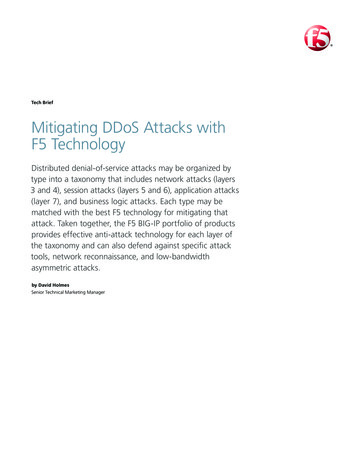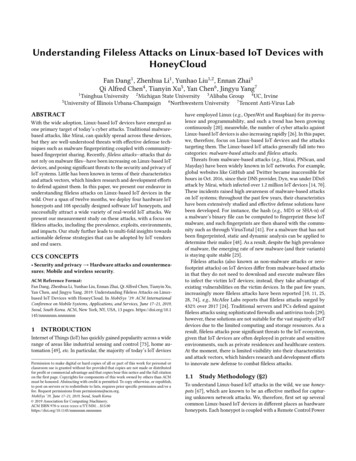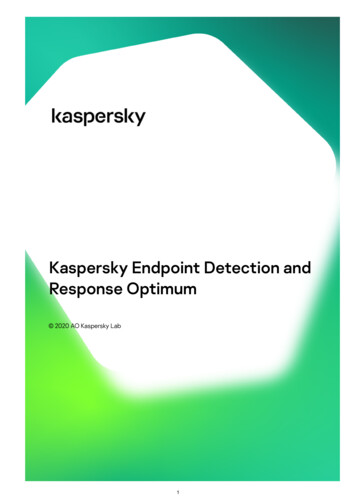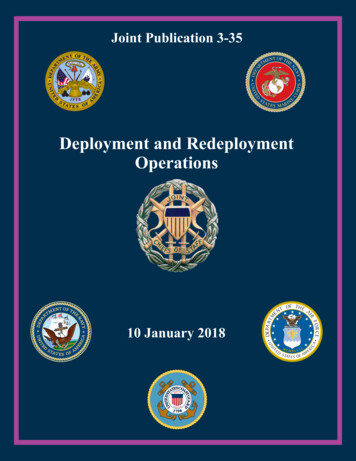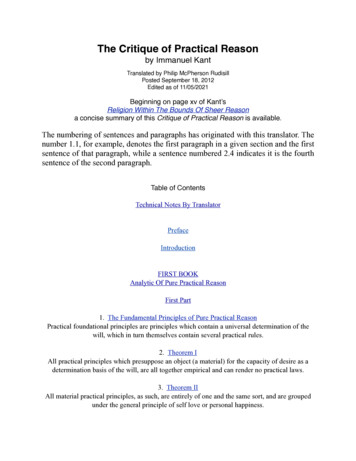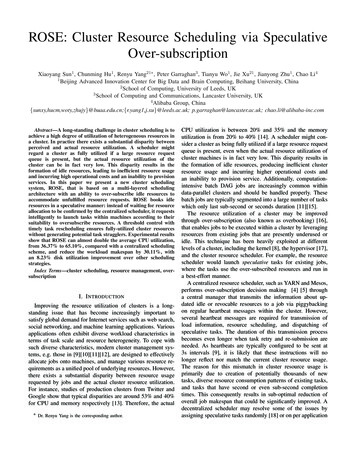
Transcription
NDA: Preventing Speculative Execution Attacks at Their SourceOfir WeisseIan NealKevin LoughlinUniversity of MichiganUniversity of MichiganUniversity of MichiganThomas F. WenischBaris KasikciUniversity of MichiganUniversity of Michigana) Control-Steering AttackABSTRACTSpeculative execution attacks like Meltdown and Spectre work byaccessing secret data in wrong-path execution. Secrets are then transmitted and recovered by the attacker via a covert channel. Existingmitigations either require code modifications, address only specificexploit techniques, or block only the cache covert channel. Ratherthan battling exploit techniques and covert channels one by one,we seek to close off speculative execution attacks at their source.Our key observation is that these attacks require a chain of dependent wrong-path instructions to access and transmit secret data. Wepropose NDA, a technique to restrict speculative data propagation.NDA breaks the attacks’ wrong-path dependence chains while stillallowing speculation and dynamic scheduling. We describe a designspace of NDA variants that differ in the constraints they place ondynamic scheduling and the classes of speculative execution attacksthey prevent. NDA preserves much of the performance advantageof out-of-order execution: on SPEC CPU 2017, NDA variants close68-96% of the performance gap between in-order and unconstrained(insecure) out-of-order execution.CCS CONCEPTS Security and privacy Hardware security implementation; Computer systems organization Architectures.KEYWORDSspeculative execution, meltdown, spectre, securityACM Reference Format:Ofir Weisse, Ian Neal, Kevin Loughlin, Thomas F. Wenisch, and BarisKasikci. 2019. NDA: Preventing Speculative Execution Attacks at TheirSource. In The 52nd Annual IEEE/ACM International Symposium on Microarchitecture (MICRO-52), October 12–16, 2019, Columbus, OH, USA.ACM, New York, NY, USA, 15 pages. ONSpeculative execution attacks [8, 13, 25, 27, 33–36, 38, 39, 45, 54,55, 59, 62, 64, 65] exploit micro-architectural behavior and sidechannels to exfiltrate sensitive information from a system. Unlikeclassical software exploits that modify and observe only architecturalPermission to make digital or hard copies of all or part of this work for personal orclassroom use is granted without fee provided that copies are not made or distributedfor profit or commercial advantage and that copies bear this notice and the full citationon the first page. Copyrights for components of this work owned by others than ACMmust be honored. Abstracting with credit is permitted. To copy otherwise, or republish,to post on servers or to redistribute to lists, requires prior specific permission and/or afee. Request permissions from permissions@acm.org.MICRO-52, October 12–16, 2019, Columbus, OH, USA 2019 Association for Computing Machinery.ACM ISBN 978-1-4503-6938-1/19/10. . . edictedbranch42Steer control- Access secret- Transmit secretb) Chosen-Code Attack1Speculative load(access secret)2Illegal accessTransmit secret43 SquashWrong-path3 SquashFault handlerWrong-pathFigure 1: Control-steering vs. chosen-code attacks. In controlsteering, the attacker steers control flow in existing victim code,inducing unwanted access to the victim’s memory space. Inchosen-code, the attacker generates code that accesses privileged data or data that belongs to another context.state (such as registers and memory), speculative execution attackshave demonstrated that attackers can retrieve secrets by controlling and observing micro-architectural state (e.g., the cache) duringspeculative wrong-path execution.Speculative execution attacks can be classified into two maincategories. One class (e.g., Spectre [34], Spectre 1.1 [33], and others [8, 13, 35, 38, 55]) allows malicious code to mis-steer a victimprogram’s control flow (e.g., by carefully mis-training branch predictors) to execute specific instructions on the speculative wrong path.Although wrong-path instructions are ultimately squashed (with noeffect on architectural state), the victim program is coerced into leaking its own memory contents through a micro-architectural channel.For instance, Chen et al. [13] show how control-flow in an SGXsecure enclave [42] can be steered to leak its own protected memory.We classify these attacks as control-steering attacks (Fig. 1a).Another class of attacks [25, 36, 45, 54, 59, 62, 64, 65] enablesunprivileged attacker code to access privileged memory that is temporarily exposed during wrong-path execution. For instance, Meltdown [36] allows reading kernel memory; Foreshadow [25, 62,65] allows reading hypervisor, OS, SMM, or SGX memory; andLazyFP [59] allows reading AES keys from AVX registers used byanother process. MDS attacks [45, 54, 64] allow reading recentlyaccessed memory belonging to other processes. Since the attackergenerates the code, they can select arbitrary instruction sequencesin both correct-path and wrong-path execution. We classify theseattacks as chosen-code attacks (Fig. 1b). These two classes of attacks are fundamentally different and therefore require differentapproaches for mitigation.Existing software defenses against speculative execution attackswork by modifying a program’s source code to block attack-specificmechanisms. Current software defenses for control-steering attacks—such as Retpoline [21, 28], IBPB [29], and improved lfence [15]
MICRO-52, October 12–16, 2019, Columbus, OH, USAinstructions—focus on preventing the attacker from steering theexecution of victim code. Unfortunately, these defenses are notimmediately applicable to existing binaries. Specifically, softwaremitigations against chosen-code attacks involve modifying the OS,hypervisor, and SMM code [23, 25, 37, 43]. A recent study byGoogle [41] discusses why software approaches aimed at mitigatingtiming channels by manipulating timers are insufficient. The authorsshow that any optimizations performed by micro-architecture, nomatter how negligible, can become observable using an amplificationtechnique. Even if code modifications are made, these defenses canbe bypassed. For instance, attackers can redirect control flow toevade fence instructions (e.g., by mis-training the branch targetbuffer (BTB) [27, 34] or the return stack buffer (RSB) [33, 35, 38]).Hardware defenses, on the other hand, have the potential to obviate the need to modify existing software [29, 31, 32, 48, 51, 53, 60,69]. The first disclosed speculative execution attacks [27, 34, 36] usecaches as a covert channel to leak data from wrong-path execution.Consequently, initial hardware defenses—such as InvisiSpec [69],SafeSpec [31], and others [32, 48, 51, 53, 60]—seek to preventwrong-path execution from leaving secrets in the cache that can laterbe recovered. Taram et al. [60] suggests a hardware modificationto automatically insert lfence micro-ops where needed. However,the authors claim mainly to address Spectre v1 attacks that use thedata cache as a covert channel.While these techniques are effective, a recent study [12] notedthat closing only the cache covert channel is insufficient to stopspeculative execution attacks, since the cache is only one of manypotential covert channels. Netspectre [55] and SMoTher Spectre [8]have already shown that secrets can be transmitted via the FPU or viaport contention [4]. In §3, we further show how to transmit secretsvia the BTB.Rather than isolating predictive structures [29] or sealing individual covert channels [31, 53, 69]—a ceaseless arms race—we insteadseek to close off speculative execution attacks at their source. Ourphilosophy is to treat potentially wrong-path values as secret andprevent these secret values from propagating through the microarchitecture. Our key observation is that speculative execution attacks require a chain of dependent wrong-path instructions to accessand transmit data into a covert channel. By preventing potentiallywrong-path values from propagating, we break these dependencychains, thwarting the code sequences required to mount attacks.We propose NDA—Non-speculative Data Access—a technique torestrict speculative data propagation in out-of-order (OoO) processors. NDA only allows instruction outputs to flow to dependents if thesource instruction is considered safe. NDA restricts data propagationby preventing tag broadcast for unsafe instructions, delaying wakeup of their dependants in the issue queue until the source instructionbecomes safe.We present a taxonomy of the building blocks of speculativeexecution attacks, show how each class of attack depends upon datapropagation in wrong-path execution, and demonstrate how we candefine safe vs. unsafe to prevent the data flow required by the attack.By composing various restrictions on when an instruction becomessafe, we create a design space of NDA variants. The variants differin (1) the constraints they place on the dynamic execution schedule(and therefore, performance), (2) the locations from which secretdata might be extracted (e.g., whether general purpose registers areWeisse, et al.protected), and (3) the kind of speculation attacks they prevent (e.g.,control-steering vs. chosen-code).NDA defeats all 25 documented [8, 12, 45, 54, 64] speculativeexecution attacks without the need to modify any existing code.Importantly, however, NDA does not preclude all speculation orOoO execution. For example, one NDA policy treats all instructionsafter an unresolved branch as unsafe. These instructions may stillexecute speculatively OoO, but they are restricted from propagatingtheir output to dependents until all preceding branches resolve. Asour evaluation demonstrates, despite delayed wake-ups, the vastmajority of the performance gap between in-order (the only othermodel known to eliminate all known speculative execution attacks)and unconstrained OoO execution is recovered.We simulate NDA designs on the SPEC CPU 2017 benchmarksuite and compare its performance to InvisiSpec [69] on the samesetup. InvisiSpec blocks data-cache-based attacks and introduces7.6-32.7% overhead in our setup. In comparison, NDA blocks allcovert channels. We show that an NDA policy that mitigates controlsteering vulnerabilities, which are fundamental to unconstrainedOoO execution, slows execution by only 10.7% and is 4.8 fasterthan in-order. If we also preclude Meltdown-like hardware implementation flaws, NDA’s strictest policy slows down execution by125% compared to an insecure OoO processor and is 2.4 fasterthan in-order execution.In short, we make the following contributions: We introduce a speculative-execution-attack taxonomy basedon how attacks induce wrong-path execution. We design NDA, a new technique to control speculative datapropagation in out-of-order processors to defeat speculativeexecution attacks. NDA offers multiple variants with differingsecurity/performance tradeoffs. We evaluate six NDA variants on SPEC 2017 and show theyare effective and efficient.2BACKGROUNDData Propagation in OoO Processors. Fig. 2 illustrates conceptualsteps in an instruction’s life-cycle in a modern OoO processor. Upondispatch into the reorder buffer (ROB), an instruction is not ready toexecute until all of its source operands—coming from instructionsS1 and S2 in Fig. 2—are ready (step 1). Once all source operandsare ready, the instruction issues and enters the execution pipeline(step 2). When execution completes (step 3), the instruction wakesits dependents (D1-D5) by broadcasting a tag corresponding to itsdestination physical register to waiting instructions (step 4), markingthose instructions ready.The essence of the NDA technique is to delay tag broadcast,i.e., transition from step 3 to step 4. Rather than waking dependentinstructions when their input operands become ready, NDA wakesthem up when their input operands are safe. We expand on this basicconcept in §5.Speculative Execution Attacks. Speculative execution attacksexploit side-effects of wrong-path execution, which are typicallyleft undefined by processor vendors. While the contents of architectural registers and memory are guaranteed to reflect precise state ofonly committed instructions, wrong-path execution affects microarchitectural structures. For instance, a wrong-path cache access
NDA: Preventing Speculative Execution Attacks at Their Source(2) Sources ready & instructionexecuting. Not completed yet(1) Source inputs not readyD1S1S1inst.D5S2S2r xcbReadyReadyD1S1D5r xcbReadyaRedyinstS2ReadyReadymay allocate new lines or modify the cache replacement order; thesechanges are not reverted when wrong-path instructions are squashed.A variety of other micro-architectural structures are also not revertedduring squash, for example, branch direction predictors (e.g., patternhistory table), pre-decoded micro-op/trace caches, memory dependence predictors, prefetchers, TLBs, fine-grain power managementstate (e.g., for FPU/AVX units), and performance counters. Statechanges in these micro-architectural structures can create side channels, where the state can be inferred, for example, based on timingparticular execution sequences. We refer to a side channel that isused to intentionally transmit data as a covert channel. Attackers canuse wrong-path execution to transmit data, via a covert channel, thatis later inferred by correct-path execution and hence leaks that datainto architectural state.PROBLEM ANALYSISWe next classify speculative execution attacks based on three fundamental attack phases that exist in all known attacks. We thendescribe the existing mitigation techniques, how they block the attacks, and their shortcomings. Lastly, to demonstrate that closingspecific side channels is insufficient, we show an attack via a newcovert channel—the BTB.3.1Classifying AttacksAttack Phases. All speculative execution attacks of which we areaware comprise three key phases—access, transmit, and recover—1 secret data is loadedshown in Fig. 3. In the Access Phase ( ),2 the secretinto a temporary register. During the Transmit Phase ( )data is covertly transmitted using micro-architectural side effectsthat are not reverted when wrong-path instructions are squashed.3 the transmitted secret is recovFinally, in the Recover Phase ( ),ered to non-speculative state (e.g., by observing the memory access1 and 2 arelatency). Whereas the instructions involved in phases 3 resultsspeculatively executed and eventually squashed, the phase 1Load secret sPhysical registerPre-process e.g.,Transmit Phase:Speculatively transmit secret via acovert channel. Preprocessingmay be requiredCacheFPUPortsD5r xcbFigure 2: Life-cycle of instructions in OoO processors. Even after the instruction has completed execution (3), the dependantinstructions (D1-D5) will not be able to access the output untilit is broadcast (4).3Restrictedmemory/registerAccess Phase:Speculatively read secret into aphysical registerD1 .S2(4) Completed & broadcast .instD5Readyr xcb(3) Instruction completed,output not broadcastS1D1Ready . .inst.MICRO-52, October 12–16, 2019, Columbus, OH, USARecover Phase:Receive covert transmissionnon-speculativelys (s&0xFF)*512s &probe[s]2Physical registerTransmit via acovert channel E.g:TT *s*sBTBTLBPHT.Probe covert channelAttacker’s Memory3Figure 3: Three phases of speculative execution attacks. Priordefenses focus mostly on the cache covert channel, failing toprevent leaks through other channels such as the FPU [55], theBTB (§3), and others.are committed to the architectural state. Wrong-path execution isessential to these attacks, as it evades software and hardware protection mechanisms that prevent the secret data from leaking througharchitectural state.Control-Steering and Chosen-Code Attacks. We classify at1tacks based on their methodology for performing the Access Phase ( )2 We divide attacks based on their Accessand the Transmit Phase ( ).Phase into two categories, which correspond to different attackerthreat models. We further subdivide these two attack classes according to the covert channel exploited in the Transmit Phase. Table 1illustrates this taxonomy for currently-known attacks.In control-steering attacks, the attacker subverts a victim program’s control flow to speculatively execute instructions that, as aside-effect, leak data into a covert channel. This attack class leaksdata to which the victim application has hardware access privileges,but are intended to be secret and might be protected (e.g., by permission or bounds checks) in software. For example, SGXPectre [13]coerces a secure SGX [42] enclave to access and leak its encryptedmemory. We illustrate control-steering attacks in Fig. 1a.Unlike a classical security vulnerability, wherein the attacker directly hijacks the program counter (e.g., a stack-smashing attackthat overwrites a return address), speculative control-steering attacksonly misdirect wrong-path execution, for example, by mis-trainingbranch predictors to direct instruction fetch to an attacker-selectedtarget. Hence, they leave no trace in the committed instruction sequence, but still leak data into a covert channel. Several approachesthat use control-steering have been demonstrated [33–35, 38].In control-steering attacks, the attacker does not typically introduce new instructions into the victim binary, rather, the attackercomposes a series of gadgets from existing code, similar to ReturnOriented Programming (ROP [11, 52, 56]).By contrast, in chosen-code attacks—our second category basedon the Access Phase—we consider an adversary who can generate
eListing 1: Exfiltrating secret data using Spectre v1 controlsteering and the cache covert channel.123456781 - access secret:// Phase secret *kernel addr; // Faulting load2 - covertly transmit secret:// Phase // Executed in wrong-path// before fault is fired:t probeArray[secret * 512];3 - recover secret:// Phase // see Listing 1Listing 2: Exfiltrating secret data using the Meltdown chosencode attack and a cache side-channel.and execute arbitrary code sequences to mount the attack. Suchan adversary already has access to its own registers and memory; these attacks instead seek to circumvent hardware protectionsthat preclude the attacker from accessing secret data in correctpath code. For instance, Meltdown [36] accesses kernel memory;Foreshadow [25, 62, 65] accesses SGX and hypervisor memory;and LazyFP [59] accesses AVX registers used by another process.These attacks exploit implementation flaws in the relative timingof hardware protection checks and data flow between wrong-pathinstructions—the secret data propagates among instructions and canbe leaked into a covert channel before protection checks squash thewrong-path execution. We show chosen-code attacks in Fig. 1b.Sample Attack Code. Listing 1 illustrates these phases for theSpectre v1 [34] bounds check bypass attack [27], which is a controlsteering attack. In this attack, the victim code includes instructionsthat access array at a given index x (Line 7). Before accessingarray, the victim code performs a bounds check on x (Line 5).To circumvent the bounds check, the attacker mis-trains the branchdirection-predictor by invoking the victim code repeatedly with avalid x.To mount the attack, the attacker now calls the victim code with anillegal value of x. The attacker chooses x such that array[x] willrefer to a location in the victim’s memory containing a secret. Thedirection predictor mis-predicts the branch on Line 5 as taken, executing Lines 7–9 on the wrong path. During wrong-path execution,1 the secret on Line 7. It then transmits ( )2the code accesses ( )the secret (still in wrong-path) on Line 9. Later, in correct-path3 theexecution, the attacker executes Lines 13–20 to recover ( )secret from the cache side-channel. The timing for each access toprobeArray on Line 16 will vary based on whether or not thecorresponding cache line was loaded on Line 9. In our evaluation,UPortsBTB- demonstrated in prior work;- demonstrated in this work- d-cache-based attacks are defeated by prior work [31,48,53,69]Table 1: Taxonomy of attacks based on secret data access1 and covert channel .2 NDA blocks all existing atmethod tacks regardless of the covert channel they use. Most commonattacks use the d-cache side channel to exfiltrate secret data. Allcurrently known chosen-code attacks use loads and load-likeoperations. Future attacks may use other instructions or othercovert transmission channels.we illustrate the difference in access timing (blue squares in Fig. 4),which reveals the secret data.Listing 2 depicts an example of a chosen-code attack—a simplified Meltdown exploit. Whereas the illegal load on Line 2 willeventually fault, the instruction on Line 6—which executes on thewrong path—will leave evidence in the cache from which the attacker can recover the secret. The recover phase is identical to thatin Listing 1. To avoid trapping into the fault handler, the attackermay use control-steering techniques to ensure the faulting load executes under a mis-predicted branch [36]. Nevertheless, we classifythe attack as chosen-code since the attacker controls the executedbinary.3.2Limitations of Existing DefensesCurrent Mitigations. Hardware defenses mitigating control-steeringattacks try to prevent the attacker from mis-training branch predictors (IBRS and STIBP [29]) or use a barrier instruction to preventspeculation after a branch or context switch (lfence/IBPB [29]).Unfortunately, recent attacks [33, 35, 38] reveal techniques to overcome these mitgations. SSBD [6, 29] disables Speculative StoreBypass (SSB, explained in §4.1) to prevent attackers from readingdata that was overwritten [27, 75]. However, SSBD only blocksSpectre v4. and introduces up to 8% overhead [26].Software defenses, such as Retpoline [21] and RSB stuffing [28],protect call and ret instructions from mis-steering. Other compiler approaches [22, 46] create a data dependency between a branchcondition and code that follows the branch, disabling speculation.However, these compiler approaches can only defeat Spectre v1 [34]attacks. A recent study suggested a compiler modification that alsor?cheachPhase 2AttackSpectre v1 [34]Spectre v1.1 [33]Spectre v2 [34,39]Ret2spec [35,38]NetSpectre [55]SMoTher Spectre [8]SSB (Spectre v4) [27] future attacks Meltdown (v3 / v3a) [27,36]LazyFP[59]Foreshadow (L1TF) [25,62,65]MDS attacks [45,54,64] future attacks Othe5Phase 1FP4i-ca3for (i 0; i 256; i ) // init channelclflush(probeArray[i*512]);1 - access secret data:// Phase // The attacker mis-trains the branch:if (x array size) { // predicted taken// wrong-path, x array sizesecret array[x];2 - covertly transmit secret:// Phase t probeArray[secret * 512];}// . somewhere else in attacker's code3 - recover secret:// Phase for (guess 0; guess 256; guess ) {addr &probeArray[guess*512];t1 rdtscp(); // read timertemp *addr; // access probing arrayt2 rdtscp(); // read timerif (t2-t1 CACHE HIT THRESHOLD)results[guess] 1;}d-c2Speculativeloads1Weisse, et al.eMICRO-52, October 12–16, 2019, Columbus, OH, USA
NDA: Preventing Speculative Execution Attacks at Their SourceMICRO-52, October 12–16, 2019, Columbus, OH, USAa) Correct BTB prediction200jumpToTargetCycles150C ache1001 predictCacheBTBCache Secret Byte (42)correctTargetb) Incorrect BTB prediction50BTB Secret Byte (42)BTB00326496128160Guess Value192224Overhead of mis-prediction:Wrong-path1 predict2562 squashjumpToTarget3Figure 4: Spectre v1, using either the cache (blue squares) or theBTB (orange circles) as a covert channel. For the cache channel,only the correct guess produces a cache hit, creating the cycledifference Cache . For the BTB channel, only the correct guesssuccessfully predicts the jump target, creating the cycle difference BT B .blocks Spectre v2 attacks [57]. Unfortunately, this approach can onlydefeat cache-based attacks with 68-247% overhead.Chosen-code attacks are mitigated by preventing speculativeloads from accessing restricted memory. For instance, Kernel Address Space Layout Randomization (KASLR [23]) and Kernel PageTable Isolation (KPTI [37, 43]) prevent Meltdown attacks from reading privileged kernel memory. KASLR [23] randomizes the kerneladdress space similar to how ASLR is used to protect user-space processes. KPTI manages separate page tables for the kernel and userspace processes, preventing user code from issuing even illegal loadsto kernel memory. KPTI swaps page tables on every transfer betweenCPU privilege levels. Mitigating Foreshadow [25, 62, 65] requiresmodifications to the OS, hypervisor, and SMM code, such as modifying page-table management, altering virtual machine scheduling, andadding L1 cache flushes when switching security domains [25, 65].Unfortunately, all these defense mechanisms block only specificexploit techniques. Therefore, one must deploy a myriad softwareand hardware defenses to be resilient against all control-steering andchosen-code attacks.Recent work suggests preventing both control-steering and chosencode attacks by blocking the cache side channel [31, 48, 53, 69], thusinterdicting the transmit phase. However, given the abundant supplyof covert channels (see Fig. 3), defeating speculative attacks by closing each channel individually is challenging. Exploits have alreadybeen demonstrated for other channels. Netspectre [55] demonstratedthat the power state of the FPU is a viable speculative covert channel. SMoTher Spectre [8] showed how to transmit data via portcontention [4]. We next show an attack via the BTB.The BTB Covert Channel. We demonstrate a new covert channel that can be exploited even when the cache covert channel is notavailable—the BTB. The BTB stores a mapping between branchinstructions’ addresses and the associated target addresses. For example, a call instruction located at address A to a function located ataddress B installs the mapping A B in the BTB. The next time theprocessor fetches the call instruction at address A, the processor’sfront-end will speculatively redirect fetch to address B.If the BTB predicts correctly (Fig. 5a), the speculatively-fetchedinstructions are eventually retired. However, if the prediction iswrongTargetcorrectTargetFigure 5: The BTB covert channel. The attacker can observe ifthe BTB prediction was correct by measuring execution time.wrong, the processor will squash the wrong-path execution, startingat the mispredicted instruction at address B, before executing thecorrect path. This recovery process is illustrated in Fig. 5b. In ourexperiments on the gem5 [9] simulator, we observe that it takes 16 cycles for the BTB miss to resolve, wrong-path execution tobe squashed, and execution to resume at the correct target (1 2 inFig. 5b). Crucially, updates to the BTB during speculation are notreverted by the squash, making it an effective covert channel. Notethat (as with caches) in the absence of security concerns, filling theBTB (and updating its replacement policy) during speculation maybe advantageous to avoid future BTB misses.To demonstrate the BTB covert channel, we construct a variant ofSpectre v1 [34] that leaks a secret byte through a speculative BTBupdate, as illustrated in Listing 3. To leak a single byte, our covertchannel comprises 256 distinct functions (targets in Line 2).During both the Transmit Phase and Recover Phase, we invoketargets only from a single call site, jumpToTarget (Line 6),ensuring that BTB entries mapping to targets all originate fromthe same PC and therefore conflict in the BTB.When the branch on Line 10 is mispredicted, the attacker canaccess any value from the process’ address space, depending on thevalue of x. The attacker then transmits the secret by speculativelycalling jumpToTarget with the secret value in Line 13. If thespeculation window is large enough, the processor updates the BTBentry for the call instruction in Line 6 based on secret.The access phase must be repeated for every guess (Line 19) sincethe recover phase is destructive: The execution of Line 21 alters thecontents of the BTB to point to targets[guess]. To confirmthat the BTB acts as the covert channel in our attack, it is importantto validate that execution time differences do not arise from i-cacheor d-cache hit or miss latency; no change to the cache hierarchyduring the attack may depend upon the secret value. To validate ourattack, we ensure the targets array in Line 2 and all 256 targetfunctions are cached during access, transmission, and recovery.We report the effectiveness of the BTB covert channel on gem5via the orange circles in Fig. 4. During the Recover Phase, in lines17-24, all the wrong guesses will incur the 16-cycle prediction andsquashing delay, as depicted in Fig. 5b. The correct guess willexecute faster, as depicted in Fig. 5a.
MICRO-52, October 12–16, 2019, Columbus, OH, USA12345678910111213141516171819202122232425// array of 256 unique target functionsvoid (*targets[256])(void);// all jumps are from the same location,// hence the same BTB entry is consultedvoid jumpToTarget(int index){ targets[index](); }void victim function(x) {1 - access secret data:// Phase // The attacker mis-trains the branch:if (x array size) {// predicted takensecret array[x];// wrong path2 - covertly transmit secret:// Phase jumpToTarget(secret); // updates BTB} }// . somewhere else in attacker's code3 - recover secret:// Phase for (guess 0; guess 256; guess ) {// Induce victim to leak secret valuevictim function(x);t1 rdtscp();// read timerjumpToTarget(guess);// BTB predictiont2 rdtscp();// read timerif (t2-t1 CORRECT PATH THRESHOLD)results[guess] 1;}Listing 3: Exfiltrating secret data using the Spectre v1 controlsteering attack and the BTB side-channel.The BTB covert channel is one of many potential machine-specifictransmission channels. We use our BTB channel PoC to demonstratethat NDA is agnostic to a
Secrets are then trans-mitted and recovered by the attacker via a covert channel. Existing mitigations either require code modifications, address only specific . S1 and S2 in Fig. 2—are ready (step 1). Once all source operands are ready, the instruction issues and enters the execution pipeline (step 2). When execution completes (step 3 .
